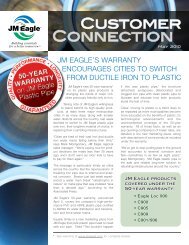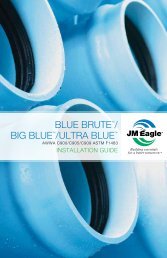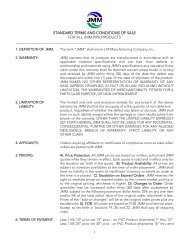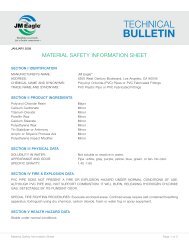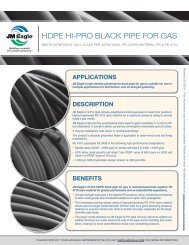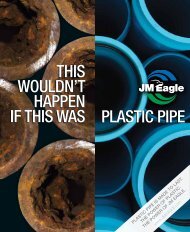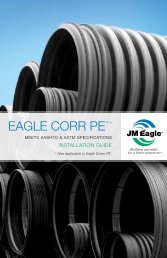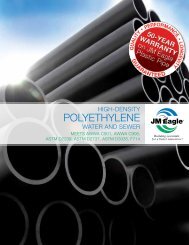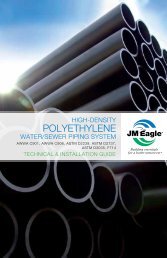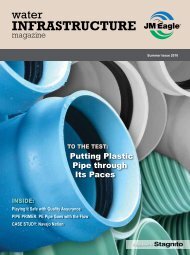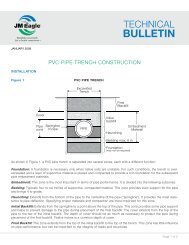I.P.S. Pressure/Irrigation (P.I.P) Installation Guide - JM Eagle
I.P.S. Pressure/Irrigation (P.I.P) Installation Guide - JM Eagle
I.P.S. Pressure/Irrigation (P.I.P) Installation Guide - JM Eagle
Create successful ePaper yourself
Turn your PDF publications into a flip-book with our unique Google optimized e-Paper software.
depths of cover (less than 3 feet) flexible conduits may deflect and rebound<br />
under dynamic loading if the trench width is not highly compacted, resulting<br />
in damage to road surfaces. For pipes buried under flexible road surfaces<br />
at depths less than 3 feet, it is recommended that a minimum of 90 percent<br />
Proctor density be achieved from the bottom of the trench up to the road surface<br />
using Class I or Class II materials as described in Appendix 1. Minimum<br />
cover is recommended to be 1-foot from the top of rigid road surfaces or the<br />
bottom of flexible road surfaces.<br />
NOTICE: For water pipe installations the top area of the bells can be left<br />
exposed for visual inspection during the test if required.<br />
4.3 Completing the Backfill<br />
Balance of backfill need not be as carefully selected as the initial material,<br />
unless specified by the engineer. Care should be taken, however, to avoid<br />
including large stones that could damage the pipe by dropping on it or by<br />
being forced down on to the pipe under the weight of the final backfill.<br />
4.3.1 Final Backfill<br />
The final backfill should be placed and spread in uniform layers in such a<br />
manner as to completely fill the trench with a uniformly dense backfill load on<br />
the pipe and avoid unfilled spaces in the backfill. Rolling equipment should<br />
not be used until a minimum of 18 inches of backfill material has been placed<br />
over the top of the pipe. If a hydro hammer is to be used to compact the<br />
backfill, a minimum of 3 feet of cover is required. Unless otherwise specified,<br />
trenches under pavements, sidewalks or roads shall be backfilled and compacted<br />
to 90 percent density, as determined by the American Association of<br />
Highway and Transportation Officials Method T99 for State Compaction and<br />
Density of Soils. Unless specified, other trenches may be backfilled without<br />
controlled compaction in the final backfill. Additional backfill material should<br />
be supplied, if needed, to completely backfill the trenches or to fill depressions<br />
caused by subsequent settlement. For description of backfill materials<br />
and their recommended usage, please refer to Appendix 1.<br />
IRRIGATION & I.P.S. PRESSURE INSTALLATION GUIDE<br />
33



